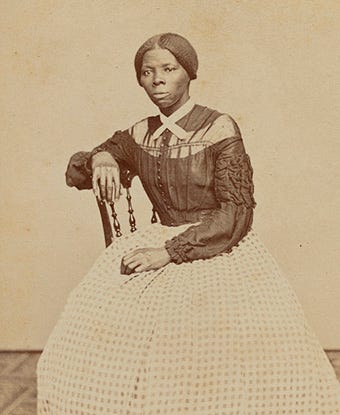Harriet Tubman is a household name, yet most of her life remains a mystery. Here is everything I learned about her in school:
She was an enslaved person who escaped to freedom.
She was the lone conductor and inventor of the Underground Railroad.
That about sums it up.
The second statement isn’t even true.
If your education about her is as sparse and incomplete as mine, allow me a few moments of your time, because this was one impressive woman.
She had a debilitating disability:
Harriet Tubman suffered from migraines, seizures and narcolepsy most of her life.
Some researchers have gone as far as suggesting she had epilepsy, but given our limited understanding of the condition at the time, no formal diagnosis was possible.
The research is a little fuzzy as to what specifically struck her in the head, but the takeaway is that it was a heavy object thrown by an overseer when she was around 12-years-old (her exact birthdate is unknown).
This caused a traumatic brain injury that stayed with her the rest of her life.
Though she received no medical treatment at the time of injury, she underwent brain surgery in 1898 in Boston to try to alleviate her condition. During the procedure, which involved the surgeon breaking into her skull, she chose not to receive anesthesia, but bit on a bullet instead!
She worked alongside white men as their colleague:
Right from the start of the Civil War, Harriet served as a nurse.
It’s easy to skim over that sentence like it’s nothing, but that was not a normal thing.
At the time, women were not professional nurses. Women were expected to nurse the sick inside their homes, for free, of course. But out in public, and especially in a nomadic army, the paid nursing gigs went to men.
The Civil War is largely responsible for bringing women into the nursing profession.
Harriet was a very early adopter.
The fact that a black woman was granted access to nurse Union troops at a time before black troops themselves were allowed in the army is not a minor detail.
She was the most successful spy the Union Army ever had:
“She has secured more intelligence from them than anybody else.”
-George Garrison, Second Lieutenant, 55th Massachusetts Regiment
Given her multiple trips behind enemy lines with the Underground Railroad, she had access to top notch intelligence. She maintained networks with both free and enslaved people throughout the country with front row access to the movements of Confederate armies and supply lines.
So greatly was her intelligence trusted, she led military scouts to map out enemy territories.
Furthermore, she was tapped by Secretary of State, William Seward, to plan and guide a group of three-hundred soldiers in the Combahee River Raid of 1863. During this overnight adventure, she navigated Union boats through mine-filled waters, then came ashore under heavy fire from slavers and Confederate soldiers to rescue over seven-hundred enslaved people from nearby plantations.
After this great success, she was recruited for similar guide work for various regiments in the Union army.
She communicated with an international covert network, but didn’t read or write:
“I was conductor of the Underground Railroad for eight years, and I can say what most conductors can’t say—I never ran my train off the track and I never lost a passenger.”
– Harriet Tubman
It was against the law to teach enslaved people to read or write, and Harriet never became literate, even after her freedom. Yet she was one of many successful conductors coordinating and operating the Underground Railroad, which she used to escape bondage herself.
Without the benefit of written correspondence, she relied on oral traditions, friendships, maps, and memory.
Theories abound on various ways the Underground Railroad was able to communicate information through illiterate conductors. I have saved that for a future post.
This is only a snapshot of an American hero. I picked some things I never knew that impressed me. This article speaks nothing of her work as a suffragette or the charity she started that far outlived her. These were noteworthy bits I found to pass along while researching the woman born “Minty” Ross, died “Moses,” and lived as Harriet Tubman in between.




Super interesting stuff. I love history and your writing is a very unique and covers many gaps not taught in traditional education. Looking forward to reading more—keep up the great work!
Harriet Tubman was an even more important, more powerful, and a more amazing person than I had even imagined! Thank you for your research, and thank you for sharing it with everyone.
You not make her story easy to read, but you add a personal feel to it. Thank you!